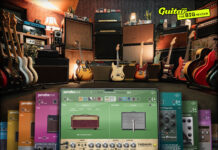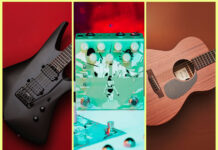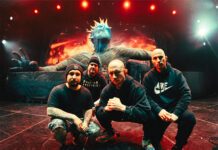
Six unique and important guitars that helped shape nu metal
Most of us have something of a love/hate relationship with nu metal. Whether you remember it the first time around or have come to appreciate its charms later on, there’s something about this fusing of rock, rap and metal that seems to inspire strong emotion even 25 years later.
READ MORE: The Gear Used by Jerry Cantrell on Alice in Chains’ ‘Dirt’
Love it or loathe it however, there can be no doubt that nu metal was a hugely important movement for the evolution of the electric guitar – while some innovations and radical ideas would catch on more than others, if not for some of the instruments below, the modern guitar landscape might be very different. Let’s take a look at six (technically seven) guitars that would shape the nu metal genre.
James “Munky” Shaffer’s Ibanez Universe 777
James “Munky” Shaffer of Korn performing with an Ibanez guitar in 2017. Image: C Brandon/Redferns via Getty Images
Few bands shaped the sound and vibe of nu metal like Korn, and at the heart of it was the Ibanez Universe – the first mass-produced seven-string guitar. Steve Vai designed the Universe for the purposes of his own shreddy needs within the confines of Whitesnake, where it was used to record the Slip Of The Tongue album in 1989. However, a few years later this guitar would find its way into the hands of a young crop of guitarists who would use its low-end thump to create an entirely new genre of music. Key among these was, Korn guitarist James “Munky” Shaffer.
Munky bought the guitar in 1990 but soon got his partner in guitar, Brian “Head” Welch in on the extended range fun – before long the two would be changing the shape of metal with their twin seven-string attack. The monster riffs the pair created lit a fire that would inspire scores of extra-string imitators, and see the pair awarded with seven-string signature models before the 90s was done.
Wes Borland’s Custom Cremona 4 String
Wes Borland of Limp Bizkit performing with his Custom Cremona 4-string in 2013. Image: Ollie Millington/Getty Images
Limp Bizkit would become poster boys for a particular sub-species of punchy, part nu metal, but in Wes Borland they had one of the genre’s most unique guitarists. Borland primarily used the Ibanez Universe for the band’s first two – and most critically acclaimed – albums, but for songs like Nookie and Full Nelson, Borland began using an Ibanez Musician MC150PW that was modified to have only four strings.
Then, when the time came to work on the band’s commercial high-point, Chocolate Starfish and the Hot Dog Flavored Water, Borland turned to a handful of custom guitars from a brand called Cremona, hand-made by master luthier, George Gorodnitski.
Borland ordered three guitars for the album two, four-string Cremonas, and one six-string. Wes referred to these guitars in a 2000 issue of Guitar World as, “the best guitars I ever played.” The string configuration on the four strings was: E .030, B .042, F .052, F (an octave lower) .080. This intriguing configuration was created by pulling strings from other guitar and bass string sets.
“He wanted a very dark, heavy sound, but transparent at the same time,” George tells us of these guitars. “It’s like playing bass with treble up. That’s why a longer scale was chosen. It added some brightness. Some people call this guitar a baritone. Nothing could be further from the truth. It’s an absolutely unique instrument. Wes gave it to PRS once, and they couldn’t reproduce this tone. So, he took it back, and he uses these guitars up to today.”
The Cremona guitars can be heard all over the Chocolate Starfish and the Hot Dog Flavored Water album and are an enduring testament to the innovation and creativity that Borland brought to nu metal guitar.
Stephen Carpenter’s Signature ESPs
Stephen Carpenter of Deftones performing with an ESP guitar in 2014. Image: Gary Wolstenholme/Redferns via Getty Images
The first Deftones record was done in E tuning, and for Around the Fur they began to down-tune (to C#). Axeman Stephen Carpenter started playing seven-string guitars in 2000. His guitar of choice for the duration of his career has been the various versions of his signature ESP guitars, the first of which came in 1998, but Carpenter had been using prototypes of his signature as early as Around the Fur. Carpenter was a leader in the charge to add more strings to his signature models, which are now available in 7- and 8-string configurations in addition to the 6-string versions.
Mick Thomson’s Jackson King V
Mick Thomson of Slipknot performing with a Jackson guitar in 2020. Image: Michael Campanella/Redferns via Getty Images
Slipknot lead man Thomson is known for his long list of signature guitars from Jackson, Ibanez, and even BC Rich. But for the recording of Slipknot’s debut album, Thomson used a Jackson King V. The King V was by no means a new model. It made its first appearance around 1986 and was made famous by Dave Mustaine. Today, Mick is now with ESP, but the crushing tones that came to define Slipknot, and nu-metal were the work of his down-tuned King V and some well-placed EMG pickups.
Brad Delson’s Custom PRS Doublecuts
Brad Delson of Linkin Park performing with a PRS guitar in 2002. Image: Scott Harrison/Getty Images
Linkin Park were one of the true superstars of the nu metal movement, and pushed the genre into crossover territories that few other bands in the genre had even attempted. Key to this was guitarist Brad Delson, who mainly played custom-made PRS Doublecut guitars tuned to drop Db.
As a forward-thinking guitar brand, PRS has always kept its eye on changing trends, but nu metal was the moment that the brand truly became a globally recognised guitar brand. In addition to Delson, PRS made a custom four-string for Wes Borland and drop-tuned guitars, while Mark Tremonti of Creed would become one of PRS’ most successful signature artists. Indeed, PRS’ early 2000s artist roster read like a who’s who of guitar bands at the time – from Nickelback to P.O.D. and beyond – but few would have the impact that Delson and his PRS would on popular music.
Gibson’s Gothic V and Fender’s Sub-Sonic Baritone
A 1999 Gibson Flying V Gothic guitar. Image: Nigel Osbourne/Redferns via Getty Images
After the new genre of nu-metal started to gain some traction, the major builders (Fender & Gibson) began to take note. Gibson’s response was a gothic series of guitars specifically geared toward metal guitarists. Gibson’s Gothic V was made from 1998 until 2002. That guitar was put to good use by Greg Tribbet of Mudvayne. Similarly, Fender came out with the Sub-Sonic in 2000 – sadly, this guitar was only available for one year, but it came with a B Standard tuning, a humbucker and two single coils, and a 27” scale, essentially making this a baritone version of a Stratocaster. That guitar is currently the weapon of choice for Chevelle’s Pete Loeffler.
The post Six unique and important guitars that helped shape nu metal appeared first on Guitar.com | All Things Guitar.
Source: www.guitar-bass.net











